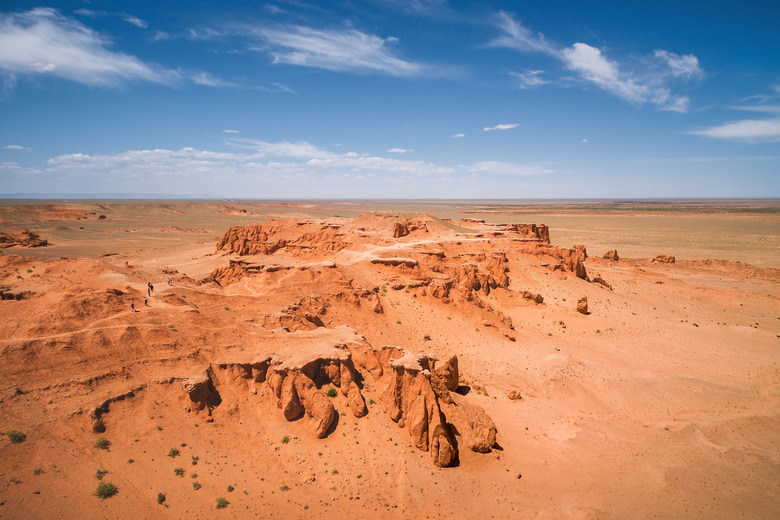What Are The Temperature Patterns Of The Gobi Desert?
When you picture deserts of the world, you might imagine vast expanses of sand, unforgiving sunlight bearing down on you and constant pervasive heat contributing to an inhospitable landscape with few trees and animals. However, as is the case in many deserts, the temperature in the Gobi Desert can vary drastically from one season to the next, and even between night and day.
Gobi Desert Temperature: Spring
Gobi Desert Temperature: Spring
Springtime in Mongolia runs through the months of February, March and April. The average daytime temperature during spring ranges from 23 degrees Fahrenheit to 63 degrees Fahrenheit depending on the month, with average temperatures steadily increasing as the months pass. The average nighttime Gobi Desert temperature during spring ranges from zero degrees Fahrenheit to 59 degrees Fahrenheit, depending on the month.
Gobi Desert Temperature: Summer
Gobi Desert Temperature: Summer
The Mongolian summer runs from May through July. The average daytime temperature during the summer ranges from 73 degrees Fahrenheit to 86 degrees Fahrenheit, depending on the month. The average temperature steadily increases with each progressive month. The average nighttime Gobi Desert temperature during the summer ranges from 48 degrees Fahrenheit to 65 degrees Fahrenheit, depending on the month.
Gobi Desert Temperature: Fall
Gobi Desert Temperature: Fall
The fall period in Mongolia runs through August, September and October. During this period, the temperature begins to steadily decrease. Average daytime temperatures in the Gobi Desert during the fall season range from 80 degrees Fahrenheit to 57 degrees Fahrenheit, with temperature decreasing as the months go on. Average nighttime temperatures during fall range from 59 degrees Fahrenheit to 33 degrees Fahrenheit.
Gobi Desert Temperature: Winter
Gobi Desert Temperature: Winter
The winter season in Mongolia begins in November and runs through the start of February. This is the coldest time period in the Gobi Desert. The average daytime temperature in the winter ranges from 41 degrees Fahrenheit to 19 degrees Fahrenheit. During the winter, the average nighttime temperature ranges from 15 degrees Fahrenheit to negative four degrees Fahrenheit.
The Landscape of the Gobi Desert
The Landscape of the Gobi Desert
Though you might imagine sand as far as the eye can see when you picture the various deserts of the world, the Gobi Desert actually has very little sand. In fact, only 5% of the Gobi Desert consists of sand! Instead, the Gobi Desert contains various types of terrain and landscapes, from mountains and mud cliffs to grassy valleys and steppes. You can also find lakes, rivers and oases.
Gobi Desert Animals
Gobi Desert Animals
With its wide variety of habitats and terrains, you can also find a vast range of different animal species living in the Gobi Desert. Mammalian predators, such as snow leopards, polecats and brown bears search for prey throughout the various landscapes. Prey species such as black-tailed gazelle, Gobi ibex, Mongolia wild ass and wild Bactrian camel also range throughout the Gobi Desert.
You can also find various bird species, including the imposing Golden Eagle, roaming the skies. Despite the cold conditions, some reptiles even thrive, including the Gobi pit viper, a subspecies of venomous pit viper.
Animals living within the Gobi Desert have to adapt to the unique temperature patterns of the region and harsh temperature variations between daytime and nighttime. Animal adaptations also vary based on the specific habitat of the Gobi Desert.
For example, the snow leopard has a large chest and lungs to help absorb as much oxygen as possible in high altitudes. They also have large nasal cavities to warm frigid air prior to it reaching their lungs.
The Gobi Desert and Paleontology
The Gobi Desert and Paleontology
The Gobi Desert also contains one of the most important paleontological sights in the world. The Flaming Cliffs excavation area was the location of the first discovery of dinosaur eggs in the world! The conditions in regions of the Gobi Desert have led to exceptionally well-preserved fossils dating back all the way to the Cretaceous period.
References
- View Mongolia: Mongolia Gobi Desert Facts
- Amicus Mongolia Travel Company: Gobi Desert – Average Monthly Temperature and Weather
- Britannica: Climate of Gobi
- World Atlas: What Animals Live in the Gobi Desert?
- View Mongolia: When to Travel to Mongolia
- Treehugger: 17 Animals Amazingly Adapted to Thrive in Deserts
Cite This Article
MLA
Zinni, Yasmin. "What Are The Temperature Patterns Of The Gobi Desert?" sciencing.com, https://www.sciencing.com/temperature-patterns-gobi-desert-19479/. 20 October 2021.
APA
Zinni, Yasmin. (2021, October 20). What Are The Temperature Patterns Of The Gobi Desert?. sciencing.com. Retrieved from https://www.sciencing.com/temperature-patterns-gobi-desert-19479/
Chicago
Zinni, Yasmin. What Are The Temperature Patterns Of The Gobi Desert? last modified March 24, 2022. https://www.sciencing.com/temperature-patterns-gobi-desert-19479/
